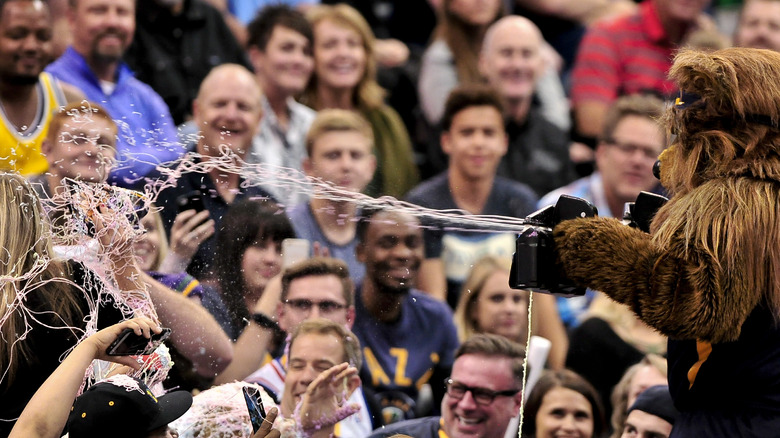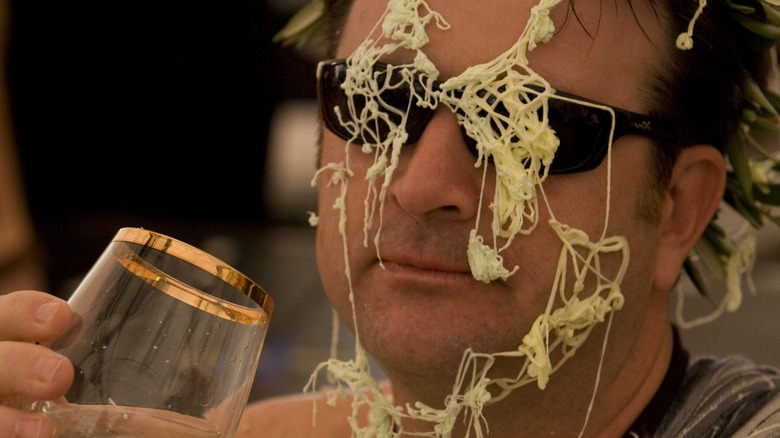What Happened To Silly String?
For as long as anyone can remember, it's been de rigueur to celebrate an accomplishment — a team's win, victory in a war, a huge personal announcement — by launching something into the air. For example, following V-J Day (the end of World War II), New York held a parade featuring tons of ticker tape being poured over the streets, as The New York Times reports. Similarly, multiple soccer fans across the world are known to deploy smoke canisters featuring their team's colors following a goal or a win, such as can be seen here via YouTube.
For a few decades now, it's been a thing to celebrate by spraying a chemical foam into the air. Perhaps you've been to a gender-reveal party where you spray different colored foam depending on the sex of the new baby. Or perhaps, just in fun, you've doused a friend or family member in the gooey substance. We're talking about, of course, Silly String (or any of several similarly-named knockoff products).
Invented by accident
Many of the products we use in our daily lives, including more than a few playthings, were invented by accident. For example, according to manufacturer Crayola, Silly Putty was invented by a scientist trying to come up with a synthetic rubber. Similarly, according to Popular Mechanics, the microwave oven was invented after a scientist found that a magnetron melted the chocolate bar in his pocket.
You can add Silly String to the list of products developed by accident. As Great Big Story explains, inventor Leonard A. Fish and chemist Robert P. Cox were attempting to create a far more useful tool than a can of colored goo. Specifically, they were trying to create an aerosol that could be stored and carried in a can and then deployed at an injured limb to create an instant cast around a broken bone. Instant casts remain elusive, but Fish and Cox did notice that their creation produced a satisfying and amusing blast of goo that shot 30 feet across the room. They realized they'd created a toy and began trying to find a manufacturer.
A bold and risky move
Leonard Fish and Robert Cox knew they had a toy on their hands, so they fiddled with their composition a bit, made their substance less sticky, and added fun colors to the mixture (per Great Big Story). Then they arranged a meeting with executives at toy company Wham-O. The two scientists had a bold plan: hose down the entire office, and the Wham-O executives, with their product, which they promptly did. It was the wrong move: they were promptly told to get out of the building.
The next day, the guys received a telegram — this was the early 1970s, after all — asking them to provide 24 more cans of the stuff for a test market. It turns out that the executive who had turned them down hadn't changed their mind, but rather, Wham-O's owners had gone into the office, found a bit of the foam on a lamp, and decided they had something exciting on their hands. Two weeks later, contracts were signed, and Silly String, as a brand, was born.
Military uses for a toy?
Many consumer products, toys included, are essentially consumer versions of devices used by the military: drones, walkie-talkies, and night-vision goggles are just a few examples. But in a rare case of a toy finding use in military applications, it seems that Silly String may have saved at least a few lives during the wars in Iraq and Afghanistan. Specifically, as CBS News reports, tripwires — which are invisible to the human eye and set off an explosive when a soldier "trips" them by walking past — are easily sussed out by Silly String.
Silly String is light enough that it doesn't trip the wires when it lands on them, but it gives a visual indication that a tripwire is present. A soldier sprays some into the air and watch where it lands; if it lands on the ground, there are no tripwires, but if it holds up on something, then it indicates a tripwire. New Jersey mom Marcelle Shriver learned about this bit of improvisation from her son, who was serving in Iraq at the time, and promptly raised enough money to send 1,000 cans of the stuff to the war zone.
Governments are skittish
Silly String is non-toxic to humans and animals, non-flammable, and safe for the environment, according to CVS. Only in very specific instances is it even remotely harmful; for example, according to Jumping Bunny Party Rentals, its use is verboten around vinyl — such as that used in children's inflatable bouncy castles — because it can degrade and discolor the substance.
Despite the negligible (but nonzero) risk to property, some cities have banned Silly String and even arrested people for using it. For example, in Cape Coral, Florida, two teenage boys were arrested for battery after spraying other juveniles with the substance (via WFXT). Similarly, according to Mother Jones, the city of Los Angeles has banned the substance — but only on Halloween. Elsewhere, in the 1990s, the town of Southington, Connecticut, banned Silly String entirely, according to the Hartford Courant.
Even the federal government had an issue with a knockoff brand. As Business Journals reports, Tween Brands was fined over $100,000 by the Environmental Protection Agency because its own brand of canned string used a banned chemical that damages the ozone layer.
Silly String is still a thing
Despite bans, arrests, and competition from knockoffs, Silly String hasn't gone away. In fact, you can purchase it or any of several knockoffs (bearing names such as Goofy String or Party String) for a few bucks per can, either online or at brick-and-mortar retailers. You can also buy them in multi-packs of a dozen or even several dozen if you're expecting an extra-large amount of merriment; you can purchase a device that looks like a science-fiction ray gun and load a can into it and spray the goo out of it for an extra effect; and you can even buy scented or glow-in-the-dark versions. In a 2007 New York Times report, the manufacturer estimated that it sold over 1 million cans of the product per year, and that says nothing of the sales of the knockoff brands.
You may be surprised that there are more uses for Silly String than just blasting it into the air for fun. As evidence for the notion that there's nothing that hasn't been tried on YouTube, creator Chris Folea came up with some alternative "uses," including making a self-portrait and a blanket. Of course, it bears noting that none of his Silly String alternative uses were actually useful at all — they were just, well, silly.





